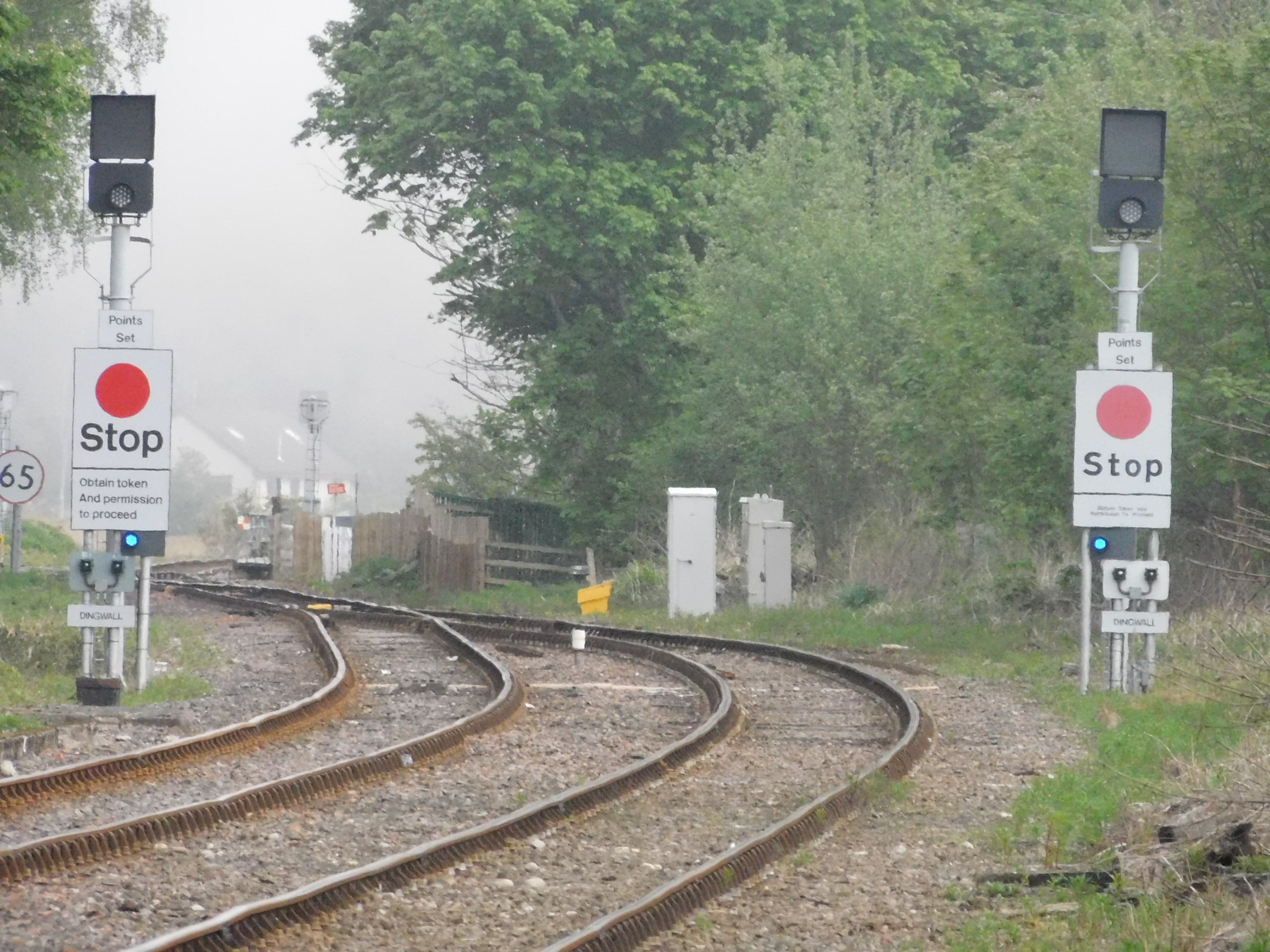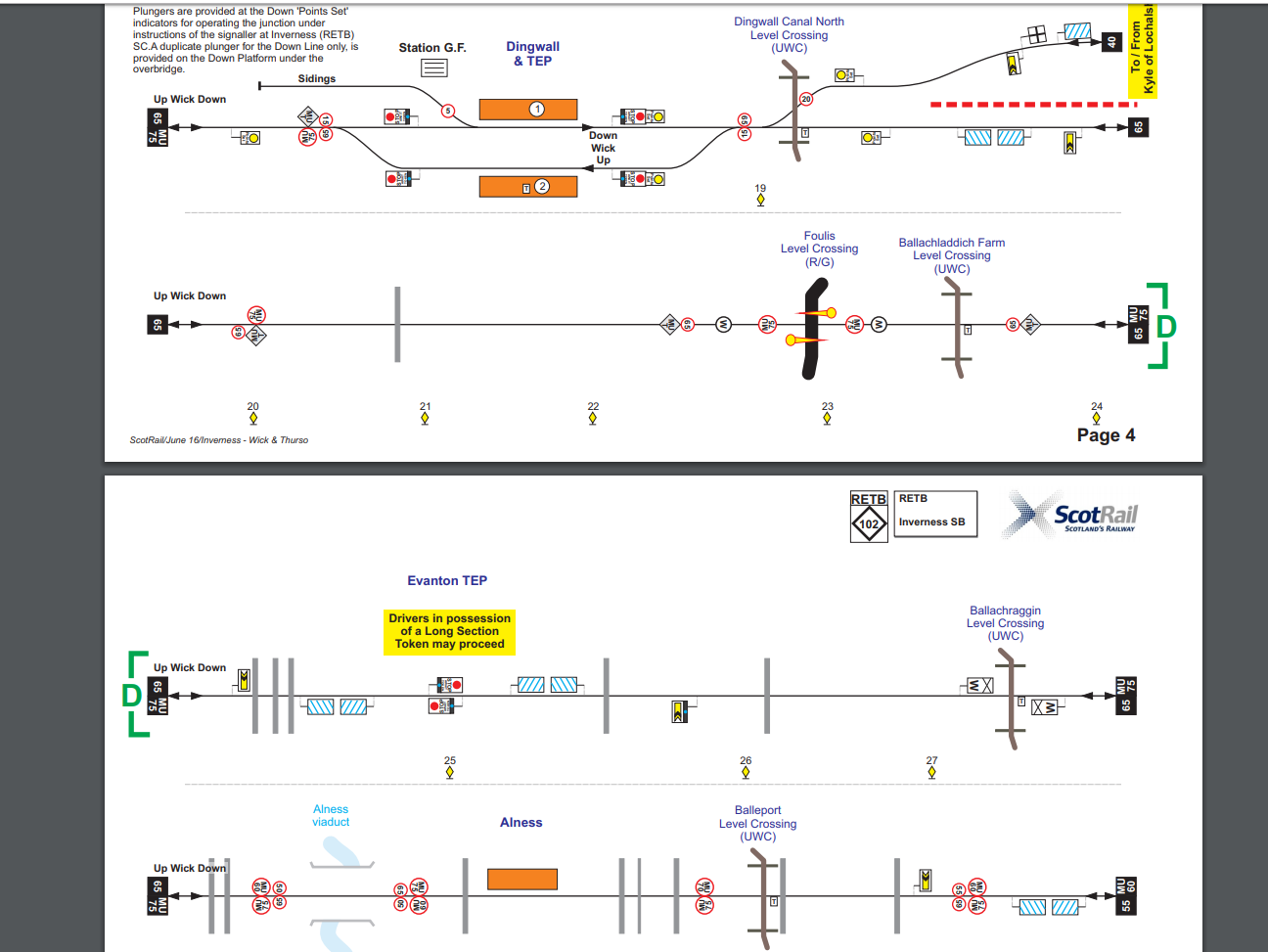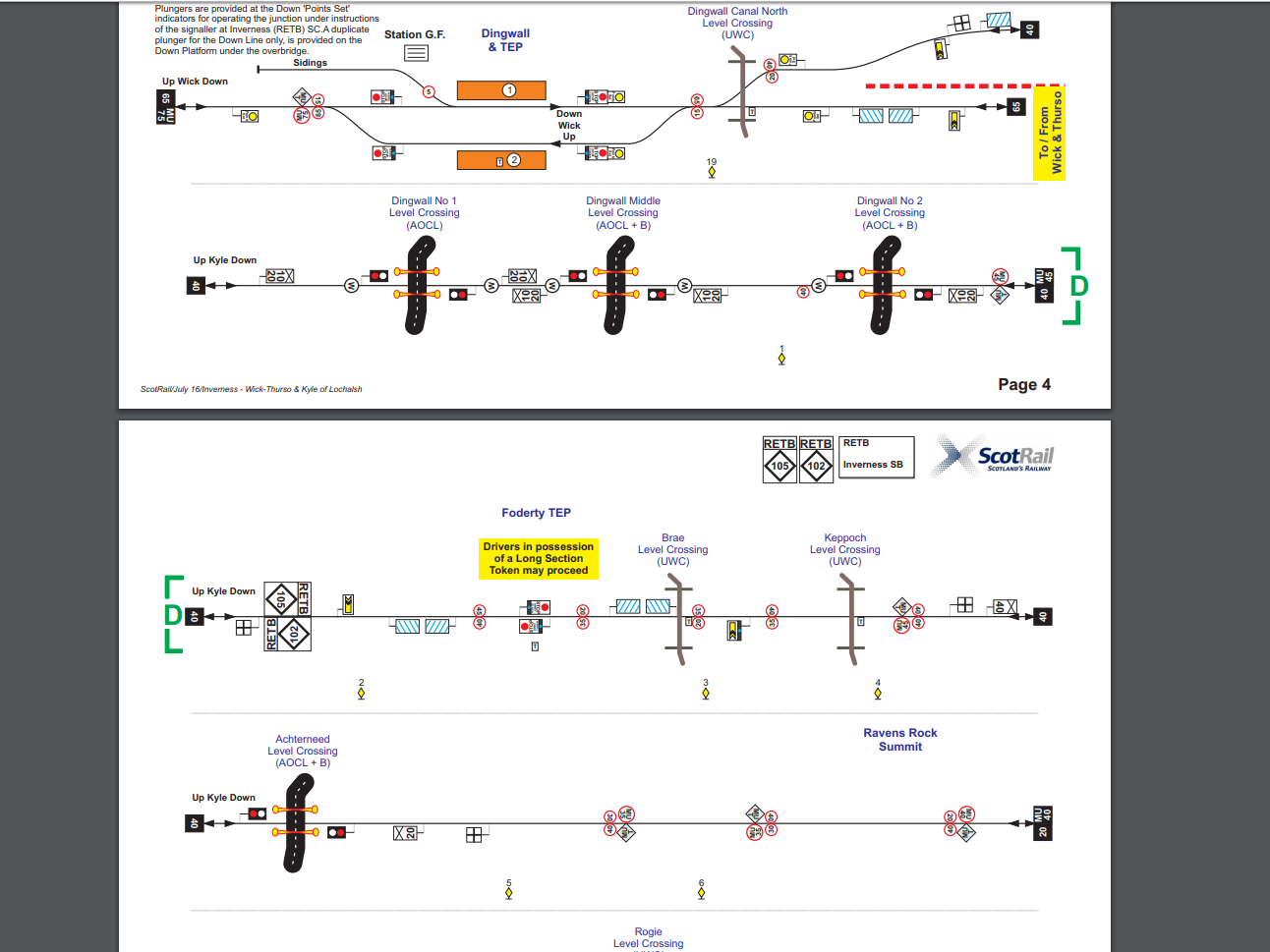Page 1 of 1
| RETB- junction stations 25/08/2019 at 21:48 #120203 | |
|
Steamer
3978 posts |
Looking at the timetable for Dingwall on the Far North line, the following question occurred to me. In the evening, 2H65 heads north to Wick at 19:05. 13 minutes later, 2H86 arrives from Kyle at 19:18. 2H86 has a Fodderty, an intermediate token exchange point 2 miles from Dingwall, at 19:11. However, 2H65 does not stop at Evanton IB, and only surrenders its token from Dingwall at Invergordon, at 19:22. How is the junction at the north end of Dingwall station protected? 2H86's call at Fodderty suggests that there's some interlocking between the Kyle and Wick line tokens, however as 2H65 is still in possession of the Wick line token when 2H86 arrives at Dingwall, it must be that both tokens from Dingwall can be issued at the same time. Or are the tokens independent of each other, and moves over the junction interlocked locally by the system that sets the junction points? The same question applies to Crianlarich on the West Highland, and Georgemas Junction further north, although in the latter case its must be very rare to have two trains in the area at the same time. "Don't stress/ relax/ let life roll off your backs./ Except for death and paying taxes/ everything in life.../ is only for now." (Avenue Q) Last edited: 25/08/2019 at 21:48 by Steamer Reason: None given Log in to reply |
| RETB- junction stations 25/08/2019 at 23:12 #120205 | |
|
bill_gensheet
1394 posts |
There is no 'system' to set the junction points. Inbound they are simply trailed, northbound you push the button on the platform, and as long as there's a train on a track circuit the points move and the 'Points Set' signal clears. Some crew even ask random bystanders to operate them. I'd suspect that the Dingwall-Evanton token can be given up on the move. Log in to reply |
| RETB- junction stations 25/08/2019 at 23:14 #120206 | |
|
Tempest Malice
122 posts |
So, the important part to how this works is that unlike physical tokes, RETB tokens have effectively two parts. One applying from the loop itself to a loop clear marker board, and the second from there to inside of the next loop (though both the cab display unit and probably the drivers will treat these as one token applying for the whole lot). So when in your example 2H65 departs Dingwall, shortly after the junction it will encounter the loop clear marker and radio back whilst on the move to indicate passing this point to the signaller who then inputs this into the system which then allows a token from Fodderty to be issued for 2H86. If I remember rightly (at least for Crianlarich), the points are operated by driver push buttons for facing moves, and are track circuit actuated for trailing moves (short TC's just before the points indicators trigger the points to operate). I assume similar applies at the other RETB junctions. Additionally in your case, whilst 2H65 doesn't stop at Evanton, trains running on long section tokens still preform the loop clear marker callback at the intermediate token exchange point which I understood to then free up the section for a standard Dingwall to Evanton token to be issuable (though given that the cab display unit of the first train will still name Dingwall on it I'm now less sure if this does actually work this way) See http://www.railsigns.uk/info/retb1/retb1.html for more information, or https://catalogues.rssb.co.uk/rgs/standards/GKGN0554%20Iss%202.pdf if you don't mind crawling through 80 page technical standards instead. Last edited: 25/08/2019 at 23:20 by Tempest Malice Reason: add links Log in to reply The following user said thank you: Steamer |
| RETB- junction stations 26/08/2019 at 14:55 #120207 | |
|
Steamer
3978 posts |
Thanks for the Rail Signs link; that's pretty comprehensive. Tempest Malice in post 120206 said: This doesn't appear to be possible- there are a few Kyle and Wick trains that follow each other closely, and both the first train and the one following it are booked to stop at Clunes IB. "Don't stress/ relax/ let life roll off your backs./ Except for death and paying taxes/ everything in life.../ is only for now." (Avenue Q) Log in to reply |
| RETB- junction stations 26/08/2019 at 19:56 #120210 | |
|
Late Turn
697 posts |
My (limited) understanding is that the “loop clear” confirmation is purely verbal, with no tokens or parts of tokens exchanged. I’m not sure whether the signalman then updates the system so that the interlocking can allow a token for the other route to be issued though?
Log in to reply |
| RETB- junction stations 26/08/2019 at 23:45 #120219 | |
|
pedroathome
915 posts |
Late Turn in post 120210 said:My (limited) understanding is that the “loop clear” confirmation is purely verbal, with no tokens or parts of tokens exchanged. I’m not sure whether the signalman then updates the system so that the interlocking can allow a token for the other route to be issued though?Shorly, the Electronic Token is the same as a physical token, and the interlocking being effectivally the same princaple. I see there being no difference between able to get a physical token out of an insturment once a train has passed a given sign, or being able to issue a different electronic token. The whole point of the token is that that train has permission to be in that Section. Otherwise you're in a situation where you have the signaller remembering where trains are, without indications, to which there has been numerious incidents with this as the cause in the past Log in to reply |
| RETB- junction stations 27/08/2019 at 06:29 #120222 | |
|
Andrew G
552 posts |
At the present time the radio call when a train with a long section token passes the intermediate loop clear marker board is only used to advise the signaller of the trains location. A short section token for the section in rear of the train cannot be issued until the long section token has been returned. It is possible in the future that the system might be enhanced to link this radio call to a keyboard action which would then free up the section in rear of the train. Last edited: 27/08/2019 at 08:49 by Andrew G Reason: None given Log in to reply The following user said thank you: Steamer |
| RETB- junction stations 27/08/2019 at 19:28 #120232 | |
|
Hap
1029 posts |
bill_gensheet in post 120205 said:There is no 'system' to set the junction points. Inbound they are simply trailed, northbound you push the button on the platform, and as long as there's a train on a track circuit the points move and the 'Points Set' signal clears.Trains have to stop at Evanton if only in possession of a short section token. Trains with long section tokens can proceed without stopping, however still need to call in for the loop clear/station limits boards. Hopefully this below will answer the questions.... Normal method of signalling trains Train departure from token exchange point or intermediate sidingWhen a driver asks for your permission for his train to enter a token section, you may issue a token if: •the line between the stop board where the train is standing and the line to which the train will proceed is clear throughout. •You have not given permission for a conflicting movement. •A token is available. •The movement is to proceed to a token exchange point, the previous train in the same direction has passed clear of the station limits board situated ahead of the token exchange point to which the train will proceed or has been shunted clear of the line concerned. •Proceeding to an opposite direction crossing loop, you have not given permission for a train to approach the crossing loop concerned from the opposite direction.You may issue a token to a train requiring to proceed to a siding even though the siding concerned is occupied. To be honest, there are so many local instructions for RETB up here. Down direction trains from Dingwall, points are operated with the plungers, but UP moving trains the points are track circuit operated. since 2010 the WHL uses a double exchange procedure. So pressing the SEND button returns the current token and the next section is issued. Can work on single to single section, single to long, long to long and long to single. the last 3 being the new facility. How to report an issue: www.SimSig.co.uk/Wiki/Show?page=usertrack:reportanissue Last edited: 27/08/2019 at 19:37 by Hap Reason: More info. Log in to reply |
| RETB- junction stations 27/08/2019 at 21:13 #120234 | |
|
Steamer
3978 posts |
Hap in post 120232 said:Sorry, another question! How are passing moves handled? The timetable shows passing trains arriving at the station concerned within minutes of each other; the above implies that two trains can't approach the same loop from opposite directions. "Don't stress/ relax/ let life roll off your backs./ Except for death and paying taxes/ everything in life.../ is only for now." (Avenue Q) Last edited: 27/08/2019 at 21:15 by Steamer Reason: None given Log in to reply |
| RETB- junction stations 28/08/2019 at 09:17 #120239 | |
|
Late Turn
697 posts |
pedroathome in post 120219 said:Late Turn in post 120210 said:My (limited) understanding is that the “loop clear” confirmation is purely verbal, with no tokens or parts of tokens exchanged. I’m not sure whether the signalman then updates the system so that the interlocking can allow a token for the other route to be issued though? Largely agreed, I think. If a long section token has been issued from A to C via B, then confirmation of being clear of the stop board at B isn’t sufficient to allow another token to be issued for a following train from A to B, and indeed the interlocking wouldn’t allow it until the long section token has been given up once the train is at C. The question was about a train arriving from a diverging route at A though, say X to A, and my understanding is that a token *can* be issued for this whilst the token for A to C is still ‘out’, although it shouldn’t be done until the latter train is confirmed clear of the loop at A? It’s broadly similar to the principle of that following train from A to C - the first train returns the token once it has arrived in the loop at C, but a token for the following train shouldn’t be issued until the first train is confirmed clear of the loop at C and the line clear to the stop board. Log in to reply |
| RETB- junction stations 28/08/2019 at 10:45 #120240 | |
|
Danny252
1461 posts |
My (perhaps naive!) query on this would be "where is the single line defined as starting"? If both the Dingwall-Evanton and Dingwall-Fodderty single line sections are judged as starting beyond the diverging points in the Down direction, only a few hundred yards north of the loop end points, then there shouldn't be an issue. That would imply there's some sort of interlocking/detection to ensure the first train has cleared the junction points before the second departs, but given that the points are power-operated, I presume there'd need to be some form of train detection no matter what the arrangement. I assume that the Up single line sections must be defined as continuing at least as far as the loop points, given the lack of any protecting signals, but this would hardly be the first instance where single line sections don't match up in either direction (after all, a semaphore-signalled line will usually have the single line section ending at the home signal in one direction, and starting at the separately located starting signal in the other). Last edited: 28/08/2019 at 10:46 by Danny252 Reason: None given Log in to reply |
| RETB- junction stations 28/08/2019 at 13:45 #120242 | |
|
Hap
1029 posts |
Steamer in post 120234 said:Hap in post 120232 said:I've messaged about some people who drive in RETB routes up here on both sides of the country. I don't sign any of those routes. Hopefully I'll get a sound answer back in the next couple of days.Sorry, another question! How are passing moves handled? The timetable shows passing trains arriving at the station concerned within minutes of each other; the above implies that two trains can't approach the same loop from opposite directions. But what I believe to understand of that is if you have a token to Dingwall from Clunes TEP. The train would go normally into Platform 1 at Dingwall. you can not therefor give a token to the South bound services if it is also going into platform 1. (Platform 1 is Down Wick, Platform 2 is Up Wick) That would effectively be a opposite direction crossing loop, putting a UP service into the Down Platform. The movement is allowed as long as it's only one train involved. Craig. How to report an issue: www.SimSig.co.uk/Wiki/Show?page=usertrack:reportanissue Log in to reply |
| RETB- junction stations 28/08/2019 at 14:30 #120243 | |
|
postal
5257 posts |
As ever the devil is in the detail and the small print. Do the platforms at Dingwall then have "stop boards" halfway along like the signalling on the platforms at Pitlochry to allow for the overlap or is there a dispensation for reduced overlap because of restricted approach speeds?
“In life, there is always someone out there, who won’t like you, for whatever reason, don’t let the insecurities in their lives affect yours.” – Rashida Rowe Last edited: 28/08/2019 at 14:30 by postal Reason: None given Log in to reply |
| RETB- junction stations 28/08/2019 at 17:38 #120247 | |
|
Steamer
3978 posts |
Hap in post 120242 said:Steamer in post 120234 said:Ah, right- but I assume it is acceptable to allow a train from the north into platform 2 while a train for platform 1 is approaching from the south?Hap in post 120232 said:I've messaged about some people who drive in RETB routes up here on both sides of the country. I don't sign any of those routes. Hopefully I'll get a sound answer back in the next couple of days.Sorry, another question! How are passing moves handled? The timetable shows passing trains arriving at the station concerned within minutes of each other; the above implies that two trains can't approach the same loop from opposite directions. Quote: Do the platforms at Dingwall then have "stop boards" halfway along like the signalling on the platforms at Pitlochry to allow for the overlap or is there a dispensation for reduced overlap because of restricted approach speeds?Must be the latter- the stop boards are at the end of the loop, and there are trains booked to arrive within minutes of each other from opposite directions. Photo of the boards attached.  Post has attachments. Log in to view them. "Don't stress/ relax/ let life roll off your backs./ Except for death and paying taxes/ everything in life.../ is only for now." (Avenue Q) Log in to reply |
| RETB- junction stations 28/08/2019 at 19:21 #120248 | |
|
Hap
1029 posts |
Steamer in post 120247 said:Hap in post 120242 said:(6) is the Wick map, (7) is the Kyle map.Steamer in post 120234 said:Ah, right- but I assume it is acceptable to allow a train from the north into platform 2 while a train for platform 1 is approaching from the south?Hap in post 120232 said:I've messaged about some people who drive in RETB routes up here on both sides of the country. I don't sign any of those routes. Hopefully I'll get a sound answer back in the next couple of days.Sorry, another question! How are passing moves handled? The timetable shows passing trains arriving at the station concerned within minutes of each other; the above implies that two trains can't approach the same loop from opposite directions. :) Craig.   Post has attachments. Log in to view them. How to report an issue: www.SimSig.co.uk/Wiki/Show?page=usertrack:reportanissue Log in to reply The following users said thank you: Steamer, postal |
| RETB- junction stations 28/08/2019 at 23:20 #120251 | |
|
postal
5257 posts |
Craig Thanks for taking the time. I expect these sort of things don't come up very often unless you are in front of the MOM trying to be passed out on the box or panel! “In life, there is always someone out there, who won’t like you, for whatever reason, don’t let the insecurities in their lives affect yours.” – Rashida Rowe Log in to reply |